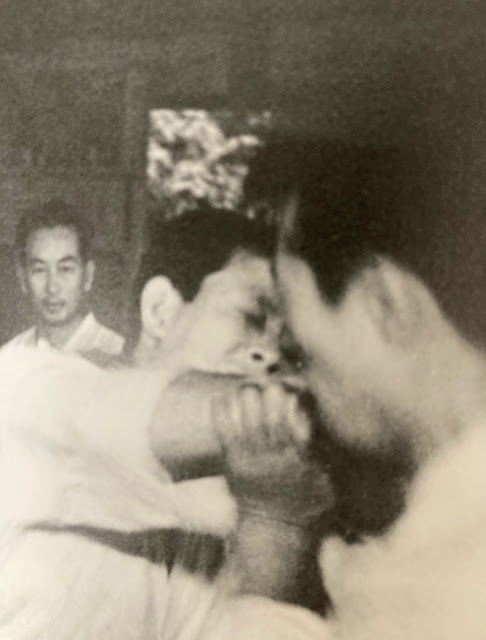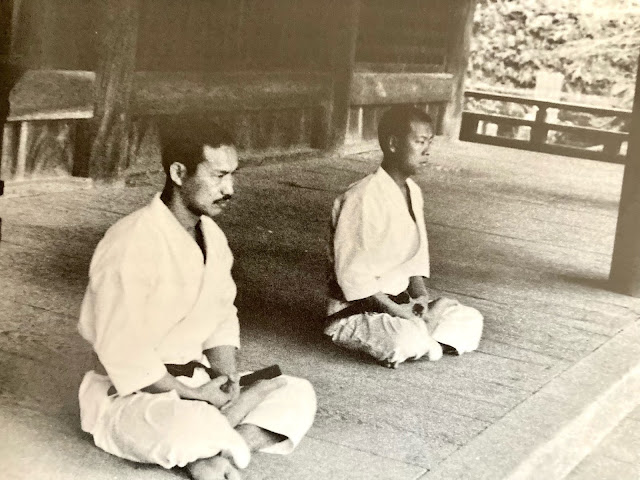Today
I will provide a translated overview of the textbook 空手道 : 精神と技法 (‘Karate-Do:
Kokoro to waza). With 390 pages the ‘Technique Section’ is largely re-hash of
the content featured ‘Dynamic Karate’ but with some updates. However, what I’ve
translated as the ‘Spirit/Heart/Mind Section’ is unique to this publication.
I’d
like to state here that when necessary I’ve added the odd word or term for
clarification; furthermore, omitted some words where they make sense in
Japanese yet become confusing in English.
That
being said, some terms may still cause some confusion as I felt unable to
replace them without distorting Nakayama Sensei’s writing. Moreover, I wanted,
as much as possible, to retain the terms he utilized in the publication.
Overall, with ‘Dynamic Karate’ already published in
English and other languages, it is unnecessary for the ‘Technique Section’ to be translated.
However, I will gradually translate the other section of the book
(the ‘Spirit/Heart/Mind Section’) and ‘THE ULTIMATE GOAL OF
KARATE-DO’.
This month marks my 40th Year since I began my Karate
Journey, more than quarter of which has been here in Japan. Nevertheless, when
considering my seniors in this art—Japanese and Westerners alike—I’m still in
awe of their excellence and knowledge. To those of you reading this, I am
sending a big bow from my dojo here to you. These karateka, many of which were direct
students of Nakayama Masatoshi Sensei, are especially inspirational for me in
my daily training. Accordingly, I really want to offer my gratitude to you all. 押忍!
Now I’d like to say that this task, time wise, is very
appropriate and, indeed, a humbling process. Unequivocally, looking at
greatness inherently does this. In this regard, I believe that in any endeavor,
the only way forward is humility as we must constantly see, understand and
evaluate ourselves with self-honesty. Moreover, from this vantage point we must
face our weaknesses and problem-solve to eradicate them. THIS TRULY IS THE PHYSICAL AND PSYCHOLOGICAL KARATE JOURNEY, which is travelled through the physical training of this form of budo.
‘Karatedo: Kokoro to waza’ shows that this must be
done by self seeking precise budo karate kihon, and also the need for seeking
the very best mentors. When we think of the numerous unparalleled karateka that
Nakayama Sensei was instrumental in producing, I think it’s impossible to think
of a better mentor in the history of the Shotokan system. Hence, his work,
especially in regards to the 'underpinning psychological aspects' of our art is
of particular importance. This point cannot be stressed enough, especially now in a world focused on 'performance dance', 'kabuki face' and 'screaming kata'; furthermore, 'tip-tap-tag kumite' followed by disgusting etiquette and 'high fives', which is unacceptable in any form of Japanese Budo/Bujutsu. Such actions only confirm the vast chasm between BUDO and sports karate.
To conclude, I hope that this is of some use to our
Shotokan Family who follow Budo Karate—irrespective of organization or dojo. Also to our Budo friends in other Kaiha/Ryuha. My best wishes and positive energy from Oita City, Kyushu,
Japan.
アンドレ
バーテル
André Bertel.
COMPLETE CONTENT OF KARATE-DO: KOKORO TO WAZA
·
Preface/Foreword
·
The 20 precepts of Shoto (The Niju Kajo)
·
Table of contents
·
Index
SPIRIT/HEART/MIND
SECTION
PART ONE
The Beginning
Chapter 1 The infancy
phase of Karate
Chapter 2 Chinese
Kenpo and the Kenpo of Okinawa
Chapter 2 From
Karate to Karatedo
PART TWO
The Long process towards to making a modern karate
competition
Chapter 1 From
exchange training style to a more formal competitive match
style
-
Brought to the 11th tournament (Mishima
Yukio)
-
Karate as a competitive sport (Tetsuo Kishiro)
Chapter 2 Differences
in ideas and behaviors: between the West and the
East
PART THREE
Karatedo scriptures
Chapter 1 What
is Karatedo
Chapter 2 Emptiness
and nothingness
PART FOUR
Zen and Budo
Chapter 1 Establishment
of modern zen in Japan
Chapter 2 Zen
content and personality
Chapter 3 The
practice of zen and the performing arts
PART FIVE
The ‘Kokoro’ (heart) of Karate-Do
Chapter 1 There
is no first attack in karate
Chapter 2 There
is no kamae in karate
Chapter 3 The
itinerary in the minds of karate practitioners
TECHNIQUE
SECTION
PART ONE
Overall perspective of the foundational techniques
Preface /
The foundational techniques of Karate-Do
1
Karate-Do is scientifically based
2
The form of physical stability and center of gravity
in movement
3
Power and speed
4
Concentration of power
5
The driving force of movements is muscular strength
6
Rhythm
7
Timing
8
‘Tanden’ and waist
Chapter 1 Stance
and posture
1
In a rotational form
2
What is a good way to make stances
3
Stance stability
4
How to practice stances
Chapter 2 Rotation
and driving force of the waist
1
About the rotation of the waist (hip rotation)
2
Extruding the waist (hip drive/thrust)
Chapter 3 Balance
/ Center of Gravity / Movement of the Center of Gravity
Chapter 4 The
limbs are also weapons
1
About limb training
2
How to use the hands
3
About the rotation of the waist (hip rotation)
PART TWO
Training of the foundational techniques
Chapter 1 Tsuki
(Thrusts) / Theory and Practice
1
How to make thrusts
2
Types of thrusts
3
The basic technicality of thrust / direct collision
Factor one: Correct Trajectory
Factor two: Speed
Factor
three: Concentration of Power
4
Gyaku-zuki
5
Stance and impact distance
6
Jun-zuki (Oi-zuki)
7
Nagashi-zuki
8
Kizami-zuki
Chapter 2 Uchi
(Strikes) / Theory and Practice
1
How to strike
2
Closed fist strikes
3
Strikes with the elbows
4
Shuto uchi (Sword hand strike)
Chapter 3 Keri (Kicking)
/ Theory and Practice
1
Kicking is a powerful weapon of karate
Factor one: Correct
knee squeeze
Factor two: Snap via
the bending and stretching of the knee
Factor three: Waist and
Ankle Spring
2
Various kicks and practice methods
Karate photographically analyzed via bursts with a strobe flash
-
Shirai Hiroshi Sensei: Tobi Yoko-geri
-
Asai Tetsuhiko Sensei: Nidan-geri
-
Yaguchi Yutaka Sensei: Yoko-geri kekomi
-
Kanazawa Hirokazu Sensei: Board breaking with mae-geri
Chapter 4 Uke (Recieving)
/ Theory and Practice
1
The characteristics of ukewaza (receiving techniques) in
Karate-Do
2
The foundational techniques of receiving
Factor one: Direction
to apply force (trajectory/course)
Factor two: Twist and
timing
Factor three: Uke with
koshi (the waist/hips)
Factor four: Relationship
between the elbows and flanks
Factor five: Do not receive
too much (over action is incorrect)
Factor six: Receiving
is also a kimewaza (Decisive technique)
3
Basic form / The procedure and practice of Ukewaza
4
Use of special parts
5
Receiving using both hands
6
Receiving kicking techniques
7
Foundational practice of receiving
PART THREE
Training of the foundational techniques
Chapter 1 Response
to jodan (upper level) attacks
Combinations of receiving and decisive
techniques (countering)
Chapter 2 Response
to chudan (middle level) attacks
Combinations
of receiving and decisive techniques (countering)
Chapter 3 Response
to gedan (lower level) attacks
Combinations
of receiving and decisive techniques (countering)
PART FOUR
Completion of foundational technique training
Chapter 1 Fundamental
practice
1
Jun zuki practice
2
Sanren zuki practice
3
Jodan age uke practice
4
Jodan age uke kara chudan gyaku zuki practice
5
Chudan ude uke practice
6
Chudan ude uke kara chudan gyaku zuki practice
7
Chudan ude uke kara yori ashi chudan yoko enpi uchi
practice
8
Shuto uke practice
9
Shuto uke kara nukite practice
10
Uraken yokomawashi uchi practice
11
Jodan kizami zuki kara chudan oi zuki, uraken jodan
yokomawashi uchi, shuto jodan sotomawashi uchi soshite shuto jodan uchimawashi
uchi practice
12
Mae geri keage practice
13
Mawashi geri practice
14
Yoko geri keage and Yoko geri kekomi practice
15
Mae geri keage kara mawashi geri, yoko geri (yoko keage
or yoko kekomi) practice
16
Ippo sagatte jodan age uke kara mawashi geri, uraken
jodan yokomawashi uchi soshite chudan jun zuki practice
17
Mawashi geri kara yoko geri (yoko keage or yoko
kekomi) practice
18
Mae geri keage de ashi onaji yoko geri kekomi practice
19
Mae geri keage kara yoko geri (keage matawa kekomi)
soshite ushiro geri kekomi practice
Chapter 2 Preparatory
exercises and Training
Junbi
undo (Preparatory exercises)
Training
of the arms and legs
Training
with the sandbag
Training
with the makiwara
How
to make a makiwara
Tools
needed for karate training
Explanation
of the various muscles necessary for karate
Map
of the vital points on the human body
THE ULTIMATE GOAL OF KARATE-DO
References
[End of content translation]
© André Bertel. Oita
City, Japan (2021).


















